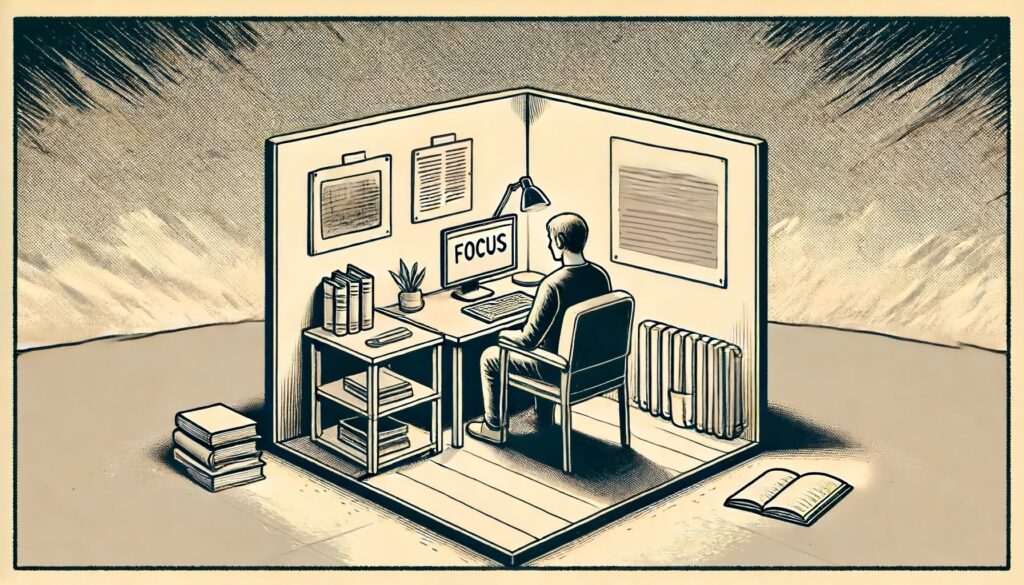“Daring to set boundaries is about having the courage to love ourselves, even when we risk disappointing others.”
Brené Brown
Picture this.
Your friend asks for a favor, your boss piles on more work, and your family expects you to be available 24/7.
Sound familiar?
It’s like you’re juggling flaming torches, praying you don’t get burned. The mere thought of saying no sends shivers down your spine. “What if they get mad? What if they think I’m selfish?” These are the fears that keep you stuck in a cycle of over-commitment and stress.
Let’s get real for a second.
Practicing healthy boundaries is not just about time management; it’s about reclaiming your power and sanity. It’s about recognizing that your needs matter just as much as anyone else’s.
But before you can most effectively exercise your power, we need to dive deep into the various personal boundary types (complete with examples) and their unexpected benefits. This will help shed light on the transformative power of personal boundaries.
So, here’s the promise: by the end of this post, you’ll have the tools to say no without feeling guilty, and reclaim the power you didn’t even know you lost.
Ready to dive in? Let’s begin by exploring these important types of boundaries:
1. Time Boundaries: Guarding Your Most Precious Asset

Time is your most precious asset. Yet, how often do you let it slip away, bit by bit, as others encroach upon your schedule? It’s not just about fitting more into your day; it’s about reclaiming your time for what truly matters to you.
Example: You’ve set aside an hour each evening for a hobby, something that recharges you. But a friend calls, needing help with something that could easily wait. You feel torn. Saying no feels like you’re letting them down. But here’s the kicker: by saying yes to them, you’re saying no to yourself.
Time boundaries aren’t just about turning down requests; they’re about prioritizing your own needs. Start small. Set specific work hours and personal time, and communicate this clearly. “I’m not available after 6 PM. How about we chat tomorrow?” Simple, direct, and respectful. By doing this, you’re affirming your goals and aspirations, making it clear that your time is valuable.
2. Emotional Boundaries: Safeguarding Your Inner Peace

Your emotions are a sacred space, a private garden where only invited guests should tread. Yet, how often do we let others trample through, leaving chaos in their wake?
Example: You’re having a rough day, and a colleague starts venting about their problems, piling their stress onto you. You want to be supportive, but you’re already at your limit. Setting emotional boundaries means recognizing when you need to protect your own well-being. Instead of fuming on the inside, you can say something like, “I’m sorry you’re going through this, but I can’t talk about it right now. Let’s catch up later.”
Emotional boundaries help you maintain control over your reactions. They preserve your peace, especially in tumultuous times. It’s not about shutting people out; it’s about letting them in on your terms. This way, you’re not constantly drained by others’ emotions.
3. Physical Boundaries: Respecting Personal Space

Physical boundaries go beyond mere touch. They encompass the environment you create for yourself, a sanctuary from the chaos of the world.
Example: You’ve carved out a small corner of your home as a no-interruption zone, a place for relaxation and personal activities. But family members keep barging in, ignoring the sanctity of your space. Politely but firmly, let them know this is your time to recharge. “I need this space to unwind. Can we talk later?”
Physical boundaries are about more than just personal space; they’re about respecting the environment that nurtures your well-being. It’s about creating a buffer against the constant demands of others.
4. Digital Boundaries: Navigating the Online World

In the age of constant connectivity, digital boundaries are more crucial than ever. They protect your mental health from the incessant ping of notifications and the unending scroll of social media.
Example: You’re trying to focus on a project, but your phone keeps lighting up with notifications. You feel compelled to check each one, disrupting your concentration. Setting digital boundaries means limiting screen time and turning off notifications during personal hours. “I’m offline after 8 PM. I’ll get back to you in the morning.”
Digital boundaries aren’t just about reducing screen time; they’re about reclaiming your focus and mental clarity. They help you create a healthier relationship with technology, ensuring it serves you, not the other way around.
5. Intellectual Boundaries: Honoring Your Thoughts and Opinions

Your thoughts and opinions are a reflection of your unique perspective, a tapestry woven from your experiences and beliefs. Intellectual boundaries ensure these are respected and valued.
Example: During a meeting, a colleague constantly interrupts you, dismissing your ideas. It’s frustrating and belittling. Setting intellectual boundaries means encouraging open dialogue where differing opinions are heard but also standing by your convictions. “I’d like to finish my point. Can we hold questions until I’m done?”
Intellectual boundaries foster creativity by ensuring your ideas aren’t steamrolled by others. They create a space where your thoughts and opinions are respected, promoting a culture of mutual respect.
6. Material Boundaries: Managing Possessions and Resources

Material boundaries reflect your values and priorities, impacting your financial health and relationships. They dictate how you handle your possessions and resources.
Example: A friend asks to borrow your car, again. They haven’t returned it on time in the past, causing you inconvenience. Setting material boundaries means being clear about your terms. “I can’t lend you my car this time. I need it for my plans.”
Material boundaries aren’t about being stingy; they’re about respecting your resources and ensuring they’re used in a way that aligns with your values. They help you manage your possessions responsibly, avoiding unnecessary stress and conflict.
7. Spiritual Boundaries: Nurturing Your Beliefs

Your spiritual beliefs are a core part of your identity, a compass guiding you through life. Spiritual boundaries ensure you stay true to these beliefs while respecting others’.
Example: You’ve committed to a daily meditation practice, a time for spiritual reflection. But others keep interrupting, not understanding its importance to you. “This time is sacred to me. I’ll be available after I’m done.”
Spiritual boundaries help you carve out space for your practices and beliefs. They ensure you can nurture your spirituality without external interference, staying grounded in your values.
8. Mental Boundaries: Protecting Your Cognitive Space

Your mind is a powerhouse of ideas and thoughts. Mental boundaries protect this cognitive space from the onslaught of external demands and distractions.
Example: You’re in the middle of a brainstorming session, but constant interruptions derail your focus. Setting mental boundaries means creating a time and space for uninterrupted thinking. “I’m focusing on something right now. Can we discuss this later?”
Mental boundaries aren’t just about shutting out distractions; they’re about creating an environment where your mind can thrive. They help you manage your cognitive load, enhancing focus and productivity.
9. Energy Boundaries: Conserving Your Vitality

Your energy is a finite resource, one that needs careful management. Energy boundaries help you conserve this vitality, ensuring you’re not constantly drained by others.
Example: You’re invited to another social event, but you’re already feeling exhausted. You don’t want to disappoint anyone, but attending would deplete your remaining energy. “I appreciate the invite, but I need to rest tonight. Let’s catch up another time.”
Energy boundaries help you recognize and respect your limits. They ensure you’re not overextending yourself, allowing you to maintain your vitality and well-being.
10. Social Boundaries: Curating Your Circle

The people you surround yourself with have a profound impact on your life. Social boundaries help you curate a circle that uplifts and inspires you.
Example: A friend constantly brings negativity into your conversations, leaving you feeling drained. Setting social boundaries means choosing to spend time with people who align with your values and distancing yourself from those who don’t. “I’d like to focus on more positive topics when we talk.”
Social boundaries aren’t about cutting people off; they’re about choosing relationships that support your growth and happiness. They help you build a supportive network, fostering positive connections.
11. Sexual Boundaries: Defining Consent and Comfort

Sexual boundaries are crucial for healthy intimate relationships. They define what you’re comfortable with, fostering trust and safety.
Example: You’re not comfortable with a certain aspect of intimacy, but you’re afraid of disappointing your partner. Setting sexual boundaries means openly discussing comfort levels, preferences, and consent. “I’m not comfortable with this. Can we try something else?”
Sexual boundaries ensure that both partners feel respected and valued. They create a foundation of trust, allowing intimacy to flourish in a safe and consensual manner.
12. Professional Boundaries: Navigating the Workplace

In the workplace, boundaries are essential for maintaining respect and work-life balance. They define what’s acceptable and what’s not, promoting a healthy work environment.
Example: Your boss asks you to stay late again, but you have personal commitments. Setting professional boundaries means being clear about your availability and workload limits. “I have commitments after work. Can we discuss other ways I can help manage the issue at hand?”
Professional boundaries aren’t about being uncooperative; they’re about ensuring your professional life doesn’t overshadow your personal life. They help you navigate the workplace with respect and balance, promoting a healthy and productive work environment.
How to Communicate Your Boundaries Effectively
Communicating your boundaries can be challenging, but it’s essential for ensuring they’re respected. Here’s how to do it effectively:
- Be Clear and Direct: Use “I” statements to express your needs without blaming others. “I need some time to myself this evening.”
- Stay Consistent: Reinforce your boundaries regularly to ensure they are respected. “I’m not available after 6 PM, as we discussed.”
- Practice Assertiveness: Stand firm in your decisions while maintaining respect for others. “I understand you need help, but I can’t do it right now.”
Reclaim Your Power and Peace
Imagine a life where you confidently say no without the weight of guilt. A life where your time, energy, and emotions are yours to manage. By setting clear boundaries, you’re not just protecting yourself – you’re enhancing your relationships and creating a space where mutual respect can flourish.
So, take a deep breath. Embrace the strength within you. You have the power to say no, to stand up for yourself, and to create the life you deserve. Each “no” is a powerful affirmation of your worth and a bold step towards a more fulfilled, balanced, and joyful existence.
FAQ
Saying no is essential to protect your time, energy, and well-being. It allows you to prioritize your own needs and avoid over-commitment, reducing stress and burnout.
Setting boundaries can help you confidently say no without guilt, allowing you to manage your time, energy, and emotions more effectively. It enhances your relationships by fostering mutual respect and creates a more fulfilled, balanced, and joyful life.
Be Clear and Direct: Use “I” statements to express your needs without blaming others. Example: “I need some time to myself this evening.”
Stay Consistent: Reinforce your boundaries regularly to ensure they are respected. Example: “I’m not available after 6 PM, as we discussed.”
Practice Assertiveness: Stand firm in your decisions while maintaining respect for others. Example: “I understand you need help, but I can’t do it right now.”

I love the illustrations for these points. It really adds to your words. Thank you!
You’re very welcome!
Great topic. I especially appreciate examples & how-tos. Thanks. Namaste`
You’re welcome, Jackie.
Thank you, Cylon.
Much appreciated – especially the diplomatic solutions.
Wishing you a good week.